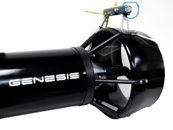I received my Genesis 3.1 a couple of week ago and have had it out a few times now. This is my first DPV so I am not qualified to give a very detailed review, but since there are so few reviews out there at the moment, I'll at least share my impressions.
The DPV is impeccably engineered and assembled. I'm a EE myself and have put many products into production over the years, and I am very impressed with the electrical and mechanical design of this DPV. The ability to charge without disassembly is great of course, but the design goes way beyond that feature and is almost what I would call military grade. It certainly provides a good feeling when taking the DPV into the open ocean.
Ride-wise, the DPV provides an extremely smooth start-up and it requires almost no support on the handle. All of the pulling load is on the tow line and your hand really just provides input for throttle and steering. It's very comfortable at a typical cruising speed. Mine is still a bit nose-light, so I need to add a little trim to the nosecone, but even in that state it handles very well.
I purchased the DPV for debris removal operations, both for shore-launched dives and from a boat, diving to near-shore areas, mostly heavy fishing areas with lots of fishing line. So far I have only used it on short runs of perhaps 1 mile total, and after several dives I still have a nearly-full battery according to the battery gauge. It's unlikely I will ever use the full range of this beast but at times I will be towing either gear or another diver so that may challenge the battery a little bit.
Noise-wise the Genesis seems very quiet to me. DPVs are common where I dive and usually I can hear the high-pitched whine from some distance, but I don't hear that whine from the Genesis. I'm not running it at full speed though so maybe at the highest speeds it starts to whine. At the lower speeds it is very quiet.
If anyone has any questions please ask. Overall I think it is a great DPV. Not the cheapest of course but for mission-critical use I think it is a great option.
The DPV is impeccably engineered and assembled. I'm a EE myself and have put many products into production over the years, and I am very impressed with the electrical and mechanical design of this DPV. The ability to charge without disassembly is great of course, but the design goes way beyond that feature and is almost what I would call military grade. It certainly provides a good feeling when taking the DPV into the open ocean.
Ride-wise, the DPV provides an extremely smooth start-up and it requires almost no support on the handle. All of the pulling load is on the tow line and your hand really just provides input for throttle and steering. It's very comfortable at a typical cruising speed. Mine is still a bit nose-light, so I need to add a little trim to the nosecone, but even in that state it handles very well.
I purchased the DPV for debris removal operations, both for shore-launched dives and from a boat, diving to near-shore areas, mostly heavy fishing areas with lots of fishing line. So far I have only used it on short runs of perhaps 1 mile total, and after several dives I still have a nearly-full battery according to the battery gauge. It's unlikely I will ever use the full range of this beast but at times I will be towing either gear or another diver so that may challenge the battery a little bit.
Noise-wise the Genesis seems very quiet to me. DPVs are common where I dive and usually I can hear the high-pitched whine from some distance, but I don't hear that whine from the Genesis. I'm not running it at full speed though so maybe at the highest speeds it starts to whine. At the lower speeds it is very quiet.
If anyone has any questions please ask. Overall I think it is a great DPV. Not the cheapest of course but for mission-critical use I think it is a great option.




